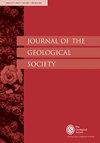Superposed Variscan and Alpine deformation in the basement rocks of southern Andorra, Central Pyrenees
IF 3
3区 地球科学
Q2 GEOSCIENCES, MULTIDISCIPLINARY
引用次数: 0
Abstract
Detailed mapping, structural analysis and cross-section constructions yield new data on the geometry and chronology of Variscan and Alpine deformations in the central Pyrenees of southern Andorra. The studied area is characterized by polyphase deformation and strain partitioning due to the presence of an efficient décollement level within Silurian black shales. Variscan macrostructures gave rise to a minimum shortening of ca. 22% for Cambrian-Ordovician and Upper Ordovician units below the décollement level and of ca. 35% for Silurian and Devonian units above it. Variscan structures are cut by out-of-sequence thrusts, presumably developed after late Variscan igneous intrusions, and extensional faulting. Those thrusts cut previous Variscan D 2 (main-phase) folds and originate additive and subtractive contacts. We propose an Alpine age for most of these thrusts which, together with the Variscan structures, are affected by subsequent Alpine deformation, which causes changes in their orientation around the intrusions, and a progressive steepening of the cleavage from south to north. We discuss the usefulness and limitations of balanced cross-sections in polydeformed areas and propose that the technique is valid to construct regional sections and to obtain geologically reasonable pre-deformational configurations.中比利牛斯山脉安道尔南部基底岩石中叠加的瓦里斯坎和阿尔卑斯山脉变形
详细的制图、结构分析和截面构造提供了安道尔南部比利牛斯山脉中部瓦里斯坎和阿尔卑斯山脉变形的几何和年代学的新数据。研究区由于志留系黑色页岩内部存在有效的变质层,具有多相变形和应变分配的特征。Variscan宏观构造使寒武系-奥陶系和上奥陶系低于dsamument水平的单元缩短了约22%,志留系和泥盆系高于dsamument水平的单元缩短了约35%。瓦里斯坎构造是由逆序逆冲(可能是在瓦里斯坎晚期火成岩侵入后发育的)和伸展断裂切割的。这些逆冲切断了先前的Variscan d2(主相)褶皱,并产生了加和减接触。我们认为,这些逆冲构造和瓦里斯坎构造都是在阿尔卑斯时代形成的,这些逆冲构造和瓦里斯坎构造都受到随后的阿尔卑斯变形的影响,这种变形导致它们在侵入体周围的方位发生变化,并使解理从南向北逐渐变陡。讨论了平衡剖面法在多变形地区的实用性和局限性,并提出该技术在构造区域剖面和获得地质上合理的变形前构造方面是有效的。
本文章由计算机程序翻译,如有差异,请以英文原文为准。
求助全文
约1分钟内获得全文
求助全文
来源期刊

Journal of the Geological Society
地学-地球科学综合
CiteScore
6.00
自引率
3.70%
发文量
68
审稿时长
6-12 weeks
期刊介绍:
Journal of the Geological Society (JGS) is owned and published by the Geological Society of London.
JGS publishes topical, high-quality recent research across the full range of Earth Sciences. Papers are interdisciplinary in nature and emphasize the development of an understanding of fundamental geological processes. Broad interest articles that refer to regional studies, but which extend beyond their geographical context are also welcomed.
Each year JGS presents the ‘JGS Early Career Award'' for papers published in the journal, which rewards the writing of well-written, exciting papers from early career geologists.
The journal publishes research and invited review articles, discussion papers and thematic sets.
 求助内容:
求助内容: 应助结果提醒方式:
应助结果提醒方式:


